© ROOT-NATION.com - Use of content is permitted with a backlink.
Junk files on a Macbook can turn into a big problem if you are not careful. Macs do not have that much disk space, to begin with, so every gigabyte is worth a lot.

Those who have had a Macbook for many years and failed to take care of junk files will have a lot of work ahead of them. Nevertheless, this step-by-step guide will take you through all the most important aspects and help you get rid of junk files.
Step #1 – Delete Email Attachments and Downloads
Those who do a lot of their communication and work via emails end up opening attachments. Every attachment from an email that you double-click gets saved in the mail folder by default. Thus, it would be worth checking out how many files have accumulated over the years.
Downloads folder is also something that, when neglected, will turn into a big issue. This easy guide by MacPaw will tell you how to deal with where to look for downloads and how to delete them.
Step #2 – Get Rid of Language Files
While language files are not something one can consider a junk file, they still serve next to no purpose. Most users need the default language, which is usually English. Or, in some cases, a native language that is other than English.
As for the remaining language files, deleting them is the best option. You will open up more disk space, and if an app comes with a 50 or so language pack, it could be as much as one gigabyte. So getting rid of it will make a difference.
Step #3 – Uninstall Old Applications
Go to Finder and locate the Application section. Sort apps by date modified and see which applications have not been used for the longest. There is also an option to sort by size. Perhaps one app is taking space, and you can find an alternative. Or maybe deleting and forgetting about it is the best option.

Applications that you remove can always be reinstalled later in case you need them. So if you are trying to make more room on the computer, do not hesitate to trim the list of installed apps.
Step #4 – Clear Caches and Backups
Caches are great. They are created to improve the data retrieval process by reducing the need to reach the underlying slower storage layer. But when you delete an application, cache files remain on the computer.
Deleting them manually is not an option. The same can be said about backups that also take quite a bit of space as well. So what is the solution? Getting utility cleanup software.
CleanMyMac X is one of the best at the moment as it has virtually anything that a good cleanup software should have, including a tool that deletes caches, backups, and any other temporary file you no longer need.
Step #5 – Empty Trash Bin
When you delete applications on other media by dragging them to the Trash Can, it does not remove the file. All this achieves is transferring the file from one location to another.
Whenever you put a file in the Trash Can, remember to press the Empty Trash. Otherwise, you will still have junk taking disk space.
Step #6 – Scan for Malware
Most users probably think of malware and viruses as a means to destroy their computer’s performance or access sensitive personal data. But there are threats that make a computer their home and slowly consume disk space without anyone realizing it.

Whether you are using a Macbook for work or personal needs is not important. Anti-virus software should be running in the background at all times. On top of that, having regular scans, like once a week, will also give peace of mind.
After all, it is better to be safe than sorry. Do not take a risk. Even more so when there are a lot of great anti-viruses available for free.
Step #7 – Use Cloud-Based Services
Dropbox and iCloud are perfect for managing computer storage. With iCloud, you get access to five gigabytes of free space. And there is an option to upgrade your account in case you want more.
Keeping some files on clouds will lessen the burden of a hard drive, and you will have to deal with less junk that gets created, like duplicates, backups, or caches.
Step #8 – Get External Storage Devices
External storage devices are another life-saver for those who are struggling with how much disk space they have to work with while using a Macbook.

Flash sticks, external hard drives, and even compact disks are excellent and also reduce the burden on the Macbook’s disk, similar to what cloud-based services do. And if you are afraid of corrupting data or losing it, there is a way to recover the files. So do not worry.

